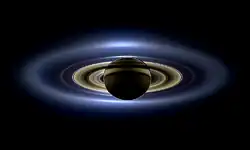Kepler-67
| Observation data Epoch J2000 Equinox J2000 | |
|---|---|
| Constellation | Cygnus[1] |
| Right ascension | 19h 36m 36.8094s[2] |
| Declination | +46° 09′ 59.167″[2] |
| Apparent magnitude (V) | 16.4[3] |
| Characteristics | |
| Evolutionary stage | main sequence[2] |
| Spectral type | G9V[3] |
| Astrometry | |
| Proper motion (μ) | RA: −3.530(41) mas/yr[2] Dec.: −8.741(39) mas/yr[2] |
| Parallax (π) | 0.8734±0.0344 mas[2] |
| Distance | 3,700 ± 100 ly (1,140 ± 50 pc) |
| Details | |
| Mass | 0.865±0.034[3] M☉ |
| Radius | 0.778±0.031[3] R☉ |
| Surface gravity (log g) | 4.594±0.022[3] cgs |
| Temperature | 5,331±63[3] K |
| Metallicity [Fe/H] | 0.012±0.003[3] dex |
| Rotation | 10.464±0.014 days[4] |
| Age | 1±0.17[3] Gyr |
| Other designations | |
| KOI-2115[5] | |
| Database references | |
| SIMBAD | data |
Kepler-67 is a star in the open cluster NGC 6811[6] in the constellation Cygnus. It has slightly less mass than the Sun and has one confirmed planet, slightly smaller than Neptune, announced in 2013.[3]
Planetary system
| Companion (in order from star) |
Mass | Semimajor axis (AU) |
Orbital period (days) |
Eccentricity | Inclination | Radius |
|---|---|---|---|---|---|---|
| b | 0.31±0.06 MJ | 0.1171±0.0015 | 15.7259±0.00011 | — | — | 0.26±0.014 RJ |
References
- ^ Roman, Nancy G. (1987). "Identification of a constellation from a position". Publications of the Astronomical Society of the Pacific. 99 (617): 695. Bibcode:1987PASP...99..695R. doi:10.1086/132034. Constellation record for this object at VizieR.
- ^ a b c d e Vallenari, A.; et al. (Gaia collaboration) (2023). "Gaia Data Release 3. Summary of the content and survey properties". Astronomy and Astrophysics. 674: A1. arXiv:2208.00211. Bibcode:2023A&A...674A...1G. doi:10.1051/0004-6361/202243940. S2CID 244398875. Gaia DR3 record for this source at VizieR.
- ^ a b c d e f g h i Meibom, Søren; Torres, Guillermo; Fressin, Francois; Latham, David W.; Rowe, Jason F.; Ciardi, David R.; Bryson, Steven T.; Rogers, Leslie A.; Henze, Christopher E.; Janes, Kenneth; Barnes, Sydney A.; Marcy, Geoffrey W.; Isaacson, Howard; Fischer, Debra A.; Howell, Steve B.; Horch, Elliott P.; Jenkins, Jon M.; Schuler, Simon C.; Crepp, Justin (2013). "The same frequency of planets inside and outside open clusters of stars". Nature. 499 (7456): 55–58. arXiv:1307.5842. Bibcode:2013Natur.499...55M. doi:10.1038/nature12279. PMID 23803764. S2CID 4356893.
- ^ McQuillan, A.; Mazeh, T.; Aigrain, S. (2013). "Stellar Rotation Periods of The Kepler objects of Interest: A Dearth of Close-In Planets Around Fast Rotators". The Astrophysical Journal Letters. 775 (1). L11. arXiv:1308.1845. Bibcode:2013ApJ...775L..11M. doi:10.1088/2041-8205/775/1/L11. S2CID 118557681.
- ^ "Kepler-67". SIMBAD. Centre de données astronomiques de Strasbourg. Retrieved 15 January 2018.
- ^ Maliuk, A.; Budaj, J. (2020). "Spatial distribution of exoplanet candidates based on Kepler and Gaia data". Astronomy & Astrophysics. 635: A191. arXiv:2002.10823. Bibcode:2020A&A...635A.191M. doi:10.1051/0004-6361/201936692. S2CID 211296456.


